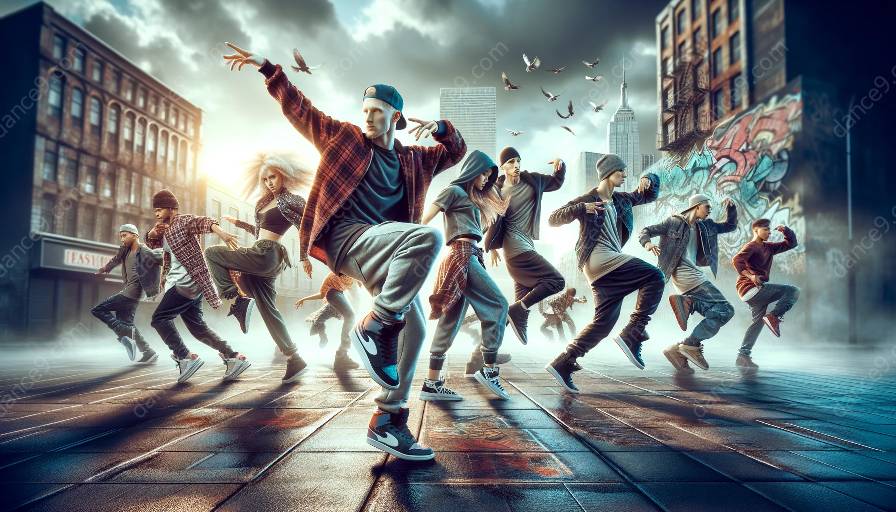Hip hop dance is a dynamic and constantly evolving art form that has been shaped by creativity and innovation over the years. From its origins in the Bronx to its integration into dance classes worldwide, hip hop dance has revolutionized the way we move and express ourselves. In this topic cluster, we delve into the rich history, cultural impact, and artistic elements of hip hop dance, exploring its influence on modern dance classes and the creative process that drives its innovation.
The Origins of Hip Hop Dance
The roots of hip hop dance can be traced back to the 1970s in the South Bronx, New York City. It emerged as a form of artistic expression for marginalized communities, blending elements of African dance, jazz, tap, and other street dance styles. Hip hop dance quickly became a vital part of the burgeoning hip hop culture, providing a platform for self-expression, storytelling, and social commentary.
Key Elements of Hip Hop Dance
One of the defining characteristics of hip hop dance is its versatility and creativity. It encompasses a wide range of styles, including breaking, popping, locking, and freestyle, each with its own unique movements, rhythms, and cultural influences. Creativity is at the heart of hip hop dance, as dancers continually innovate and push boundaries to create new moves, combinations, and choreography.
Innovation and Evolution
As hip hop dance spread beyond its origins, it underwent an evolution that saw it assimilating with other dance styles and embracing new influences. This cross-pollination led to the development of fusion styles such as jazz-funk, contemporary hip hop, and street jazz, expanding the creative possibilities of hip hop dance. Innovators in the hip hop community continue to push the boundaries of the art form, incorporating elements of storytelling, theatricality, and visual effects to create compelling and emotionally resonant performances.
Hip Hop Dance in Modern Classes
Today, hip hop dance has become a staple in dance classes around the world, attracting both aspiring dancers and enthusiasts alike. Its emphasis on individual expression, musicality, and dynamic movement makes it an engaging and accessible style for students of all ages and skill levels. Many dance studios and education programs integrate hip hop dance into their curriculum, offering students the opportunity to explore their creativity and develop their own unique style.
Integration with Other Styles
One of the most notable aspects of hip hop dance is its ability to adapt and collaborate with other dance forms. It has influenced and been influenced by contemporary, ballet, and other styles, leading to the emergence of hybrid genres that blur the lines between traditional categorizations. This integration has sparked new avenues for creative experimentation, allowing dancers to cross-pollinate movement vocabularies and artistic concepts.
Embracing Diversity and Inclusion
The inclusive and community-oriented nature of hip hop dance has contributed to its widespread appeal and longevity. It provides a platform for individuals from diverse backgrounds to come together, share their stories, and express their experiences through movement. As a result, hip hop dance has become a catalyst for promoting diversity, inclusivity, and social awareness within the dance community.
The Creative Process in Hip Hop Dance
Behind every innovative and captivating hip hop dance routine lies a deep and intricate creative process. Dancers draw inspiration from a variety of sources, including music, personal experiences, social issues, and urban culture. They experiment with different movement dynamics, explore improvisation, and collaborate with other artists to bring their visions to life. The creative process in hip hop dance is marked by a spirit of exploration, risk-taking, and authenticity, empowering dancers to express their individuality and leave a lasting impact on audiences.
Pushing Boundaries and Defying Norms
At the core of hip hop dance's creativity and innovation is a fearless attitude towards challenging conventional norms and expectations. Dancers seek to push the boundaries of movement, storytelling, and artistic presentation, often incorporating unconventional techniques, concepts, and themes into their performances. This fearless approach not only drives the evolution of hip hop dance but also inspires future generations to embrace authenticity, individuality, and creative risk-taking.
Breaking Stereotypes and Empowering Voices
Throughout its history, hip hop dance has served as a powerful vehicle for breaking stereotypes and amplifying marginalized voices. It has provided a platform for individuals to reclaim their narratives, share their struggles and triumphs, and celebrate their cultural heritage through movement. This empowerment through dance has redefined the boundaries of creativity and innovation, fostering a culture of artistic fearlessness and social consciousness within the hip hop dance community.













































































